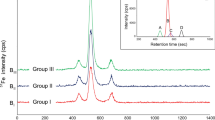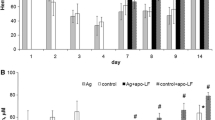Abstract
ICR male mice aged 5 weeks were injected subcutaneously with CdCl2, Pb(CH3COO)2, AgNO3, CuCl2, a combination of Cd and Ag compounds, or a combination of Cu and Ag compounds. These injections were carried out 3 times. Twenty-four hours after the last injection, they were sacrificed. Cd injection significantly stimulated serum ceruloplasmin (Cp) activity and Cu concentration, accompanied by an increase in hepatic Cu. Pb injection also slightly increased the Cp level. In contrast, Ag injection markedly decreased both Cp activity and Cu concentration in the serum. Hepatic Cu increased slightly after Ag injection. Using a combination of Cd and Ag, only the Ag effect on the Cp activity appeared. The Cu injection stimulated Cu binding to metallothionein (MT) and bile excretion of Cu, but not Cp release. With a Cu and Ag combination, the effect of Ag on Cp was lost, with a concomitant disappearance of Ag from the Cp fraction in the serum. Our results suggest that in the mouse, Cd and Ag, Cu antagonistic metals, influence different sites of Cp metabolism. Excess hepatic Cu is partly eliminated by excretion of bile and is partly detoxified by MT induction.
Similar content being viewed by others
References
Ashby SL, King LJ, Parke DVW (1980) Effect of acute administration of cadmium on the disposition of copper, zinc and iron in in the rat. Environ Res 21: 177–185
Bremner I, Campbell JK (1980) The influence of dietary copper intake on the toxicity of cadmium. Ann NY Acad Sci 355: 319–332
Brown DH, Dunlop J, Smith WE, Teape J (1979) Copper distribution and reactivity in serum following administration of cuprous oxide to rats and guinea pigs. Agents and Actions 9: 575–580
Campbell JK, Mills CF (1974) Effects of dietary cadmium and zinc on rats maintained on diets low in copper. Proc Nutr Soc 33: 15A-17A
Evans GW, Majors PF, Cornatzer WE (1970a) Induction of ceruloplasmin synthesis by copper. Biochem Biophys Res Commun 41: 1120–1125
Evans GW, Myron DR, Cornatzer NF, Cornatzer WE (1970b) Age-dependent alterations in hepatic subcellular copper distribution and plasma ceruloplasmin. Am J Physiol 218: 298–302
Evans JL, Abraham PA (1973) Anemia, iron storage and ceruloplasmin in copper nutrition in the growing rat. J Nutr 103: 196–201
Funakoshi S (1983) Ceruroplasmin. Protein Nucleic Acid and Enzyme Suppl: 373–388 (in Japanese)
Goldstein IM, Kaplan HB, Edelson HS, Weissmann G (1979) Ceruloplasmin: a scavenger of superoxide anion radicals. J Biol Chem 254: 4040–4045
Holmberg CG (1944) On the presence of a laccase-like enzyme in serum and its relation to the copper in serum. Acta Physiol Scand 8: 227–229
Holmberg CG, Laurell CB (1948) Investigations in serum copper: II. Acta Chem Scand 2: 550–556
Holmberg CG, Laurell CB (1951) Investigations in serum copper: III. Acta Chem Scand 5: 476–480
Holtzman NA, Gaumnitz BM (1970) Studies on the rate of release and turnover of ceruloplasmin and apoceruloplasmin in rat plasma. J Bio Chem 245: 2354–2358
Klauder DS, Petering HG (1977) Anemia of lead intoxication: a role for copper. J Nutr 107: 1779–1785
Under MC, Houle PA, Isaace E, Moor JR, Scott LE (1979) Copper regulation of ceruloplasmin in copper-deficient rats. Enzyme 24: 23–35
Milne DB, Weswig PH, Whanger PD (1969) Influence of copper status on copper-64 metabolism in the rat. Biochem Med 3: 94–104
Osaki S, Johnson DA, Frieden E (1966) The possible significance of the ferrous oxidase activity of ceruloplasmin in normal human serum. J Biol Chem 241: 2746–2751
Osaki S, Johnson DA (1969) Mobilization of liver iron by ferroxidase (Ceruloplasmin). J Biol Chem 244: 5757–5758
Owen Jr CA (1974) Similarity of chronic copper toxicity in rats to copper deposition of Wilson's disease. Mayo Clin Proc 49: 368–375
Planas J, Frieden E (1973) Serum iron and ferroxidase activity in normal, copper-deficient, and estrogenized roosters. Am J Physiol 225: 423–428
Poulik MD, Weiss ML (1975) Ceruloplasmin. In: Putnam FW (ed) The plasma proteins, vol. 2. Academic Press, New York, pp 51–108
Pribyl T, Monakhov NK, Vasilyev VB, Shavlovsky MM, Gorbunova VN, Alenikova TD (1982) Silver-containing ceruloplasmin without polyphenol oxidase activity in rat serum. Physiol Bohemoslov 31: 569–571
Ragan HA, Nacht S, Lee GR, Bishop CR, Cartwright GE (1969) Effect of ceruloplasmin on plasma iron in copper-deficient swine. Am J Physiol 217: 1320–1323
Roser HP, Lee GR, Nacht S, Cartwright GE (1970) The role of ceruloplasmin in iron metabolism. J Clin Invest 49: 2408–2417
Schosinsky KH, Lehmann HP, Beeler MF (1974) Measurement of ceruloplasmin from its oxidase activity in serum by use of o-dianisidine dihydrochloride. Clin Chem 20: 1556–1563
Sowa B, Steibert E (1985) Effect of oral cadmium administration to female rats during pregnancy on zinc, copper, and iron content in placenta, foetal liver, kidney, intestine, and brain. Arch Toxicol 56: 256–262
Sugawara N (1977) Influence of cadmium on zinc distribution in the mouse liver and kidney: role of metallothinein. Toxicol Appl Pharmacol 42: 377–386
Sugawara C, Saitoh T, Sugawara N (1981) Behaviour of human serum zinc, calcium, magnesium and albumin on sephadex column depending on buffer concentration. Sapporo Med J 50: 493–498 (in Japanese)
Sugawara N, Sugawara C (1984) Comparative study of effect of acute administration of cadmium and silver on ceruloplasmin and metallothionein: involvement of disposition of copper, iron and zinc. Environ Res 35: 507–515
Sugawara N, Sugawara C, Miyake H (1984) Effects of subcutaneous and oral cadmium on iron metabolism: role of ceruloplasmin and metallothionein. Arch Toxicol 56: 25–28
Terao T, Owen Jr CA (1976) Effects of copper deficiency and copper loading on 67Cu in supernatants of rats organs. Tohoku J Exp Med 120: 209–217
Whanger PD, Weswig PH (1970) Effect of some copper antagonists on induction of ceruloplasmin in the rat. J Nutr 100: 341–348
Author information
Authors and Affiliations
Rights and permissions
About this article
Cite this article
Sugawara, N., Sugawara, C. Relationship between ceruloplasmin and Cu status involving metallothionein induced by several heavy metals in the mouse. Arch Toxicol 59, 432–436 (1987). https://doi.org/10.1007/BF00316210
Received:
Accepted:
Issue Date:
DOI: https://doi.org/10.1007/BF00316210




